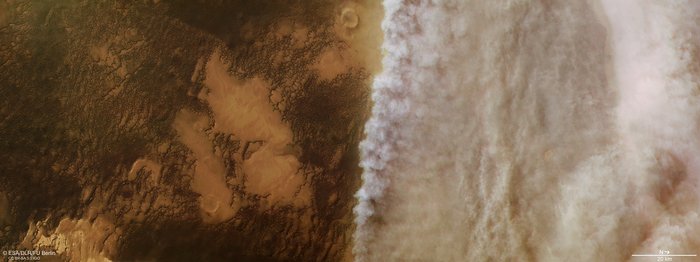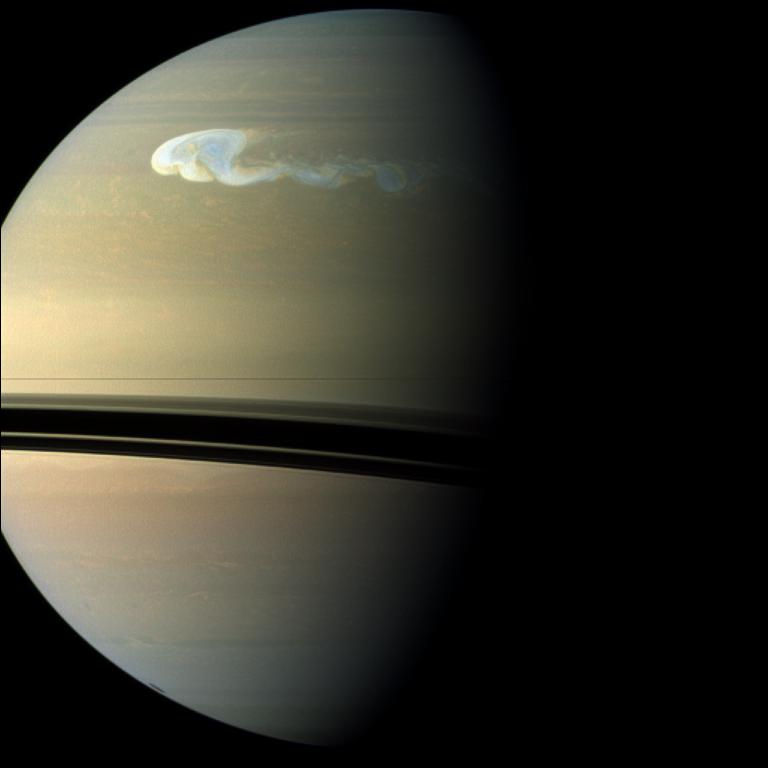Last week I talked about weather on Earth, both in fact and fiction. This week, suitably enough, it’s time to think about the other planets in our solar system. And there’s plenty to talk about.

The obvious first place to start is Mars – the atmosphere is thin there (ground level on Mars is about the same as 30 km altitude here, high above the Himalayan peaks), but it’s well able to have weather patterns. There are seasonal changes, with the polar ice caps (frozen CO2, or dry ice, rather than water ice) growing and shrinking as the planet tilts one pole or the other towards the sun. Then there are erratic changes, such as dust storms which can build up over a substantial area. The Martian opened with one such storm, and the book version had a second which threatened Mark Watney’s journey towards rescue (the film skipped over this one). In the real world, back in the summer, one such storm of vast proportions cut off communication between NASA’s Opportunity rover and mission control. The problem here is not actually caused by fierce winds buffering the craft, but that the dust has blocked its ability to capture sunlight and so generate electricity (the exact problem Watney faced late on in The Martian).

Venus has ferociously fierce winds, and if ever we try to build a permanent settlement on the surface there (which personally I doubt, since orbital or high atmospheric bases would probably suffice) then they will need immensely strong anchors, and extraordinary resistance to high levels of heat and acidity. There are outline plans at present for building a lander able to survive for a few months, rather than the few hours which is all that has been achieved to date. Jupiter and Saturn have no discernible surface – probably one exists, but the pressure would be intolerable well before you reached it. They also have huge storms spreading thousands of miles across.

But several of the moons of the giant planets are more promising. Recently, dust storms were spotted on Saturn’s moon Titan… not sand as might be on Earth or Mars, but great clouds of organic hydrocarbon molecules are stirred up into its atmosphere. So there’s definitely weather on Titan, and pretty much everywhere else we look.
Moons like Titan have been known to have atmospheres for some time, but as well as this, our solar system contains a lot of small bodies which used to be thought of as entirely airless. Closer investigation has shown that many of these actually have very thin layers of air around them. In some cases these are probably generated by underground deposits of liquid and gas which slowly ooze to the surface and evaporate. In others, we don’t yet know how they came into being. But these discoveries are reshaping how we think of our sibling worlds, and by extension the worlds we are spotting around other stars.

Back in 1950, EE (Doc) Smith, in First Lensman, could describe Pluto as being rocky and entirely barren. We couldn’t say that any more, not after the New Horizons probe sent back this fantastic image of air and clouds above Pluto. In Liminal Zone, my protagonists on Pluto’s moon Charon witness such changes both outside the dome where they live, and also when they look up at Pluto. Weather, it seems, is pretty universal, and will go on forming a topic of conversation for a lot of years to come.
And in a final stop-press, the existence of a new dwarf planet has just been announced. The finders were actually looking for the enigmatic Planet Nine, whose existence is suspected from a variety of gravitational anomalies in the orbits of other far-out objects. That has still not been detected, but instead they found 2015 TG387, dubbed The Goblin for simplicity. This newly recognised member of our solar system has a fantastically elongated orbit. At closest approach it is still well outside the orbit of Pluto, and at aphelion it strays 35 times as far away. It takes around 40,000 years to complete an orbit: last time it was in its present position we were sharing much of the planet with Neanderthals.

